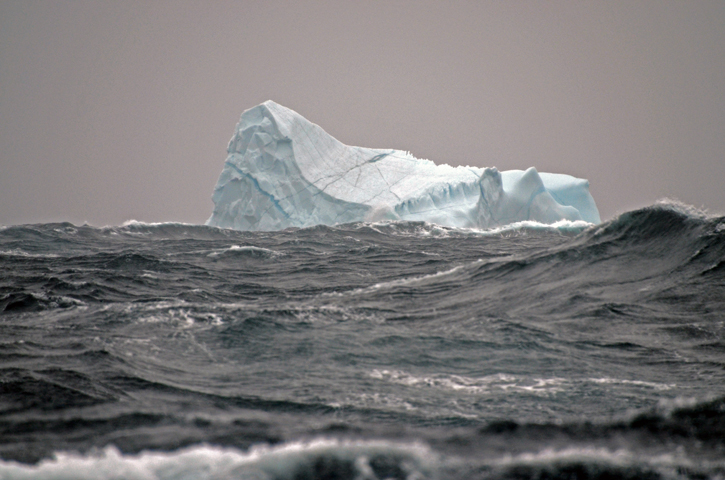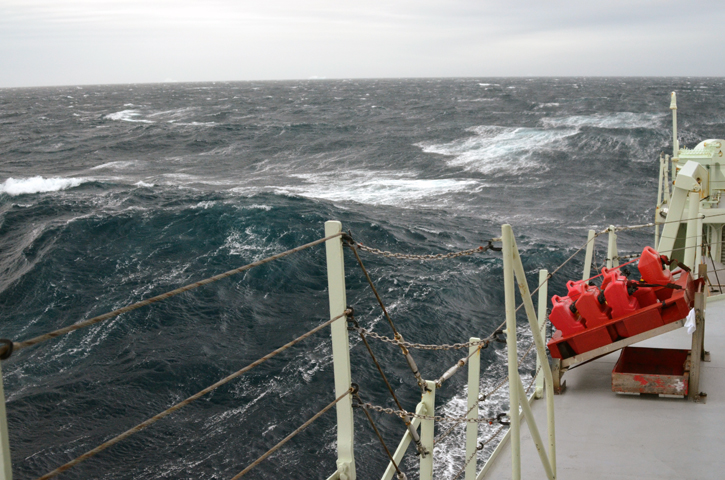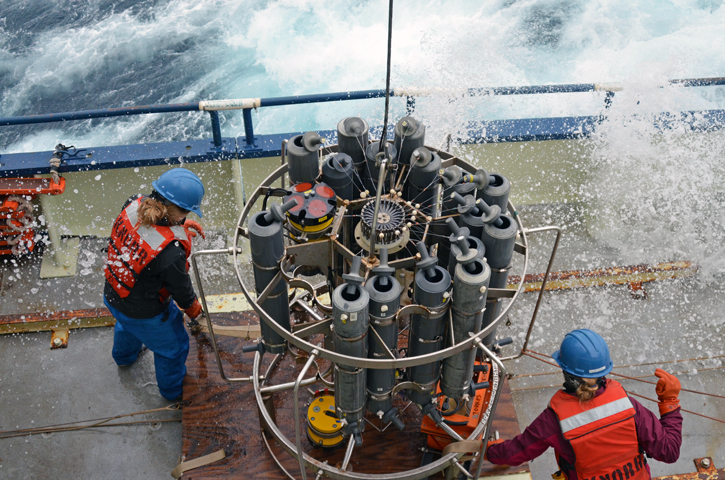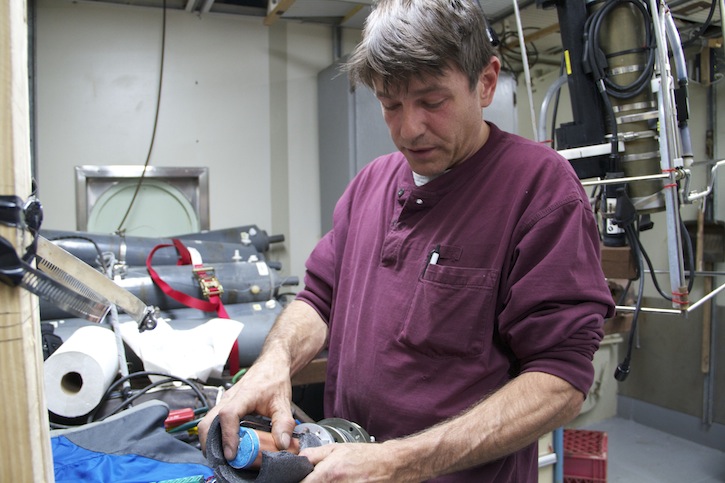August 30, 2011We began to feel the swells about midnight. Swells, technically speaking, are different from waves, though they’re often mistakenly used interchangeably. Waves are directly wind driven, whereas swells are either leftover surface disturbances after heavy weather has passed or disturbances pushed ahead of an approaching storm still some distance away. The latter was probably the case last night. The old salts in Cape Horn sailing ships used to call swells “dogs before the master.” Now we’re seeing genuine waves, in a tick over 30 knots, with those distinctive snakes of foam running down their faces. Three icebergs lie out on the horizon, and under the glowering gray skies, the breakers shine as if with internal light. It’s really quite beautiful, though there are those who’ll think me an idiot for putting it that way. But it’s easy for me to say, since, lacking seamanly responsibilities I have the leisure to observe nature.
Heavy weather coming. © Rachel Fletcher The Danish Meteorological Institute (DMI) predicts the gale to last through today and Saturday, so the seas will likely build, since duration is one of the factors responsible for wave formation. Wind velocity is one of the others, obviously. Then there’s fetch, the distance of open water over which the wind blows. As mentioned in passing the other day, the longer the fetch, the larger the seas. Our position as of 1100 Friday (69° North by 023° West), 120 miles north of Iceland, 90 miles east of Greenland puts us in open ocean with no land to windward. The fetch is virtually unlimited. However, this doesn’t imply, given the present wind velocity and fetch, that the seas will just build and build over the next day and a half, because another fundamental principle comes into play—the fully developed sea state. For a given velocity, fetch, and duration, waves will reach only a certain height and grow no higher. A way to say it is that the sea is filled up with energy under present conditions and can’t take any more. This would change if more energy were introduced in the form of increased wind velocity. But in this, there is another “however.”
Developing gale. © Rachel Fletcher When meteorologists report wave height of, say, ten meters they are not talking about every wave. They’re talking about the highest one-third of the waves, or in the parlance, the significant wave height. But a percentage of the waves in that one-third will be higher, sometimes much higher, than the average. The old Cape Horners used to call them “niners,” observing that every ninth wave in the wave train was considerably higher than its colleagues. This may not have been very scientific, but it illustrates the principle. Anomalously higher waves occur because all waves don’t travel at the same speed. One may overtake its predecessor becoming in an imprecise sense two waves. Or the “master” may overtake the “dogs” and thereby grow in size. And things get really miserable when a storm passes, leaving behind big swells, and then another storm blows in from a different quadrant, setting up what’s descriptively named a “confused sea,” and the poor vessel gets battered from two or more directions at once.
Deploying the CTD in 35 knots of wind. © Rachel Fletcher The above description applies more directly to mariners than to sea-going oceanographers, but not by much. Bob just stopped by to show me the latest ice report from the Danish Meteorological Institute (DMI). (None of us will forget their advisory from the 2008 cruise: “URGENT: Any vessels between 18 and 20 West should seek shelter IMMEDIATELY. Hurricane-force winds….”) These people have been of invaluable service to the expedition, and Bob, now on a first-name basis with the forecasters, has been effusively complementary. Their ice report is highly customized in its scale and detail, a flag marking Knorr’s position as of 0600 UTC, the new name for Greenwich Mean Time. The report shows a 100-mile-long banner of sea ice streaming southeast from Greenland at about 75° N out into the Iceland Sea, as a result of this gale-force northerly wind. This forestalls, for now, Bob and Kjetil’s plans to complete the west end of the present CTD line, then steam north along the Greenland coast to begin a new line along 70° N. To reach that line would have required us to steam right through the swath of ice. We can’t do that. Knorr’s bows are reinforced against ice, but she’s not certified to operate in ice. Sea ice, by the way, has a number of colorful names depending on its size and concentration—grease ice, brash ice, pancake ice, for instance. But the most dangerous for us and other vessels is an often-solitary chunk of glacial ice less than one meter high and less than five in length called a growler. In many instances, growlers are too small to show up on radar. Icebergs are no problem, because even small ones come up clearly on radar. So the point for us is that the concerns of mariners and those of oceanographers coincide on the surface of the sea. Today is one of those occasions.
Yes, and there’s another way mariners and oceanographers share similar concerns and problems—mechanical and/or electrical breakdowns. The all-important sensors in the CTD have died due to flooding. The techs were poised to swap out the entire sensor package for a spare only to find that one of the new sensors didn’t work; they may or may not be able to fix it. But even if they manage to get it functioning, we’ll likely divert to Iceland for a replacement package. I doubt Bob would dare continue without a spare, given that the rest of the cruise depends exclusively on CTD data. All this high-tech electronic gear that quite literally makes modern physical oceanography possible and that aboard Knorr that distinguishes her as a research vessel is wonderful…when it works. Last updated: December 27, 2011 | |||||||||||
Copyright ©2007 Woods Hole Oceanographic Institution, All Rights Reserved, Privacy Policy. | |||||||||||





 Science technician Anton tries to fix the ailing CTD instrument. © Ben Harden
Science technician Anton tries to fix the ailing CTD instrument. © Ben Harden